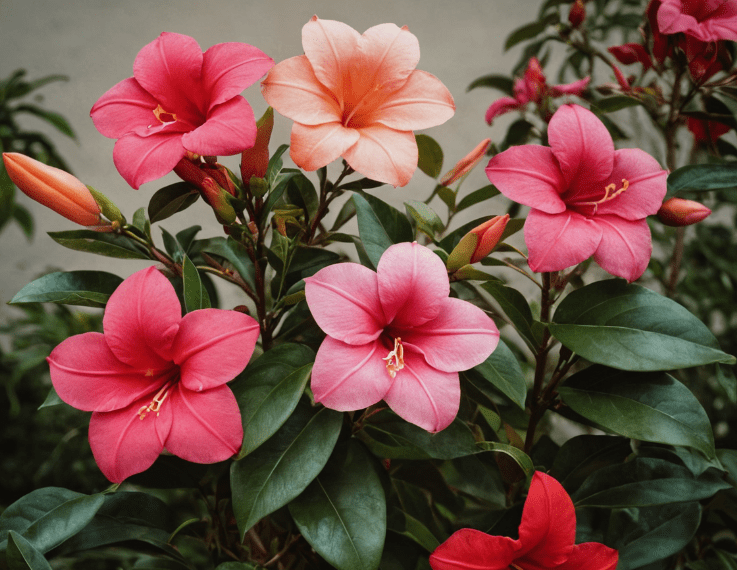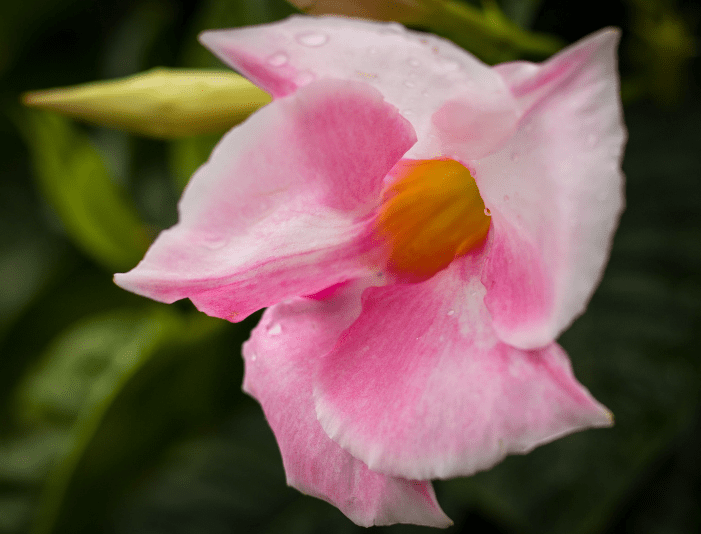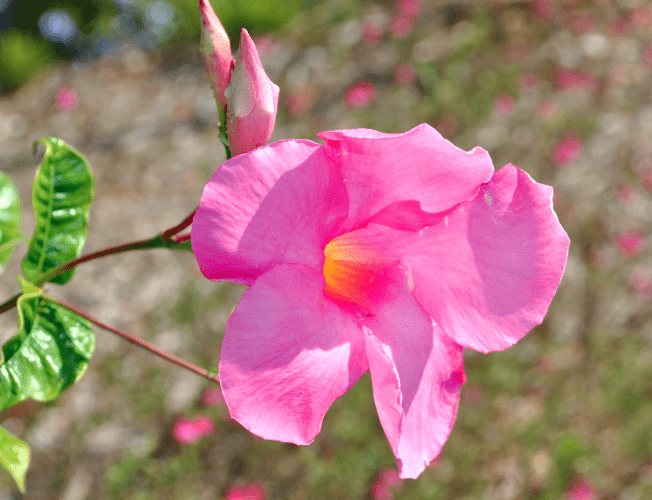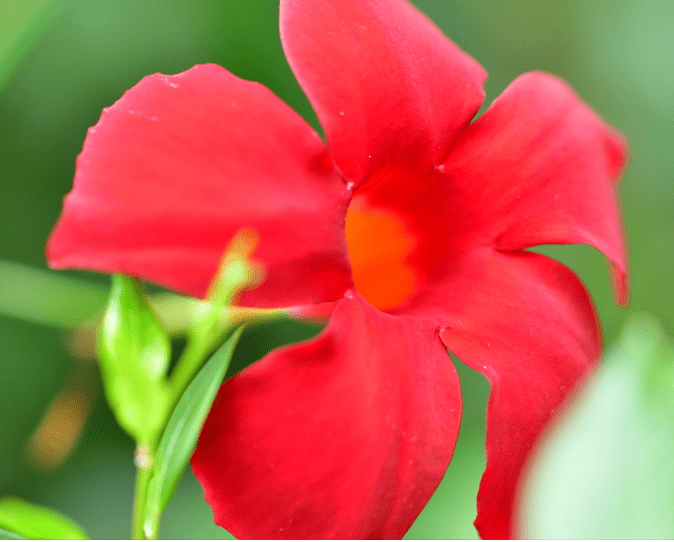
Elevate your garden with the vibrant beauty of Mandevilla. This tropical vine, renowned for its trumpet-shaped blooms and lush foliage, is a gardener’s dream. Whether you’re looking to create a cascading waterfall of color or a fragrant vertical tapestry, Mandevilla has something to offer.
Join us as we explore the world of Mandevilla, from its origins to expert care tips, ensuring you confidently cultivate this stunning plant.
Mandevilla
Origins and History
Mandevilla is a genus comprising over 100 species of perennial tropical vines and shrubs. Native to Central and South America, particularly the Brazilian forests, Mandevilla was named in honor of Henry Mandeville, a British diplomat and passionate gardener in the 19th century. Its exotic allure has made it a popular ornamental plant worldwide.
Botanical Characteristics
- Family: Apocynaceae (Dogbane family)
- Growth Habit: Evergreen climbing vine
- Leaves: Opposite, glossy, dark green, and oval-shaped
- Flowers: Large, trumpet-shaped with five petals; colors range from white, pink, red, to yellow
- Blooming Season: Late spring to first frost
Popular Mandevilla Varieties
1. Mandevilla sanderi (Brazilian Jasmine)

Mandevilla sanderi, also known as Brazilian jasmine, is famous for gardeners seeking a vibrant and versatile vine. Its bright pink-to-red flowers contrast sharply against its lush green foliage. This variety is ideal for containers, trellises, or hanging baskets, adding a touch of tropical elegance to any space.
2. Mandevilla boliviensis

Mandevilla boliviensis, with its large, fragrant white flowers and yellow centers, is a genuinely majestic plant. This variety is perfect for creating a fragrant oasis in your garden. Its climbing habit allows it to be trained on trellises or arbors, adding height and visual interest.
3. Mandevilla laxa (Chilean Jasmine)

Mandevilla laxa, or Chilean jasmine, is a deciduous vine that offers stunningly fragrant white flowers. Unlike other Mandevilla varieties, this one is more cold-tolerant, making it suitable for cooler climates. It’s an excellent choice for creating a fragrant privacy screen or adding a touch of exotic beauty to your garden.
4. Sun Parasol Series: A Gardener’s Delight

If you’re seeking a Mandevilla variety that combines stunning beauty with exceptional performance, the Sun Parasol Series is a must-have. Bred for larger, more vibrant flowers and increased disease resistance, these hybrids are a favorite among gardeners worldwide. The Sun Parasol Series offers a range of colors, including pink, red, and yellow, making it easy to find the perfect shade to complement your garden.
5. Dipladenia (Rock trumpet)

Often confused with Mandevilla, Dipladenia (also known as Rocktrumpet) is a closely related genus with similar characteristics. However, Dipladenia typically has a more bushy growth habit and smaller flowers. It’s a popular choice for containers and hanging baskets, adding a touch of tropical charm to patios and balconies.
Planting Mandevilla
Climate and Hardiness Zones
- USDA Zones: 9-11
- Temperature: Thrives in temperatures between 60-80°F (15-27°C)
- Humidity: Prefers high humidity but can adapt to average conditions
Soil Requirements
- Type: Well-draining, sandy or loamy soil enriched with organic matter
- pH Level: Slightly acidic to neutral (pH 6.0-7.0)
- Drainage: Essential to prevent root rot; consider raised beds or containers if soil drainage is poor
Sunlight and Placement
- Light Exposure: Full sun to partial shade; at least 6 hours of direct sunlight for optimal blooming
- Placement: South or west-facing locations are ideal; shelter from strong winds
Caring for Mandevilla
Watering
Watering Mandevilla
Consistent moisture is critical to healthy Mandevilla growth. Water deeply at the base of the plant, ensuring the soil is evenly moistened but not waterlogged. Avoid overhead watering, as wet foliage can lead to fungal diseases. During the growing season, check the soil moisture every 1-2 days and water as needed. In the winter, watering frequency is reduced as the plant enters a dormant phase.
Fertilization
- Type: Balanced liquid fertilizer (e.g., 10-10-10) or high-phosphorus fertilizer to promote flowering
- Frequency: Every 2-4 weeks during the growing season
- Application: Follow package instructions to avoid over-fertilization
Fertilizing Mandevilla
To promote vigorous growth and abundant flowering, fertilize your Mandevilla regularly. Use a balanced liquid fertilizer (e.g., 10-10-10) or a high-phosphorus fertilizer during the growing season. Apply fertilizer every 2-4 weeks, following the package instructions. Avoid over-fertilization, as it can lead to salt buildup and root damage.
Pruning and Training
Pruning Mandevilla
Proper pruning is essential for maintaining a healthy and attractive Mandevilla plant. Prune your Mandevilla in late winter or early spring before new growth begins. Remove any dead, diseased, or crossing stems.
To control the size and shape of your plant, lightly prune back the main stems. For a more compact appearance, prune more aggressively. Use trellises, stakes, or wires to guide the growth of your Mandevilla and create the desired shape.
Pest and Disease Prevention
While Mandevilla is generally resistant to pests and diseases, it can be susceptible to specific problems. Common pests include aphids, spider mites, whiteflies, and mealybugs. Monitor your plants regularly for signs of infestation and take action promptly. Insecticidal soaps, neem oil, or horticultural oils are effective natural remedies.
To prevent diseases like powdery mildew, root rot, and leaf spot, ensure good air circulation around your plants, avoid overhead watering, and use well-draining soil.
Propagation Techniques
Mandevilla can be propagated from seeds or stem cuttings. To propagate from seeds, collect mature seed pods and sow them in a sterile potting mix. Keep the seeds moist and warm until they germinate. Take a 4-6 inch cutting from a healthy, non-flowering stem to propagate from stem cuttings.
Remove the lower leaves and dip the cut end in the rooting hormone. Plant the cutting in a moist, well-draining rooting medium and cover it with a plastic bag to retain humidity. Place the pot in indirect light until the roots are cut.
Overwintering Mandevilla
- Indoors: Before first frost, move container plants indoors to a bright location
- Cutting Back: Prune to manage size and remove any pests
- Care: Reduce watering; maintain temperatures above 50°F (10°C)
- Dormancy: Expect reduced growth and flowering during this period
Create Stunning Landscapes with Mandevilla
Mandevilla’s versatility makes it a perfect choice for a variety of landscaping projects. Train it on trellises or arbors to create a vertical garden, or plant it in containers for patios and decks. Combine Mandevilla with other tropical plants like hibiscus or bougainvillea for a vibrant mixed border. For a natural privacy screen, train Mandevilla along fences or pergolas.
Frequently Asked Questions
Here are some frequently asked questions about Mandevilla, along with concise answers:
- Is Mandevilla toxic to pets? Yes, the Mandevilla plant is poisonous to humans and pets in all its parts.
- Can Mandevilla be grown indoors year-round? While possible, Mandevilla requires bright, indirect light and high humidity indoors, which can be challenging to maintain.
- How do I encourage my Mandevilla to produce more flowers? Ensure your Mandevilla receives adequate sunlight, regular fertilization, and proper pruning.
- Why are the leaves on my Mandevilla turning yellow? Yellowing leaves can indicate overwatering, poor drainage, nutrient deficiencies, or pest infestations.
- Can Mandevilla tolerate frost? Most Mandevilla varieties are not frost-tolerant and should be protected from cold temperatures.
Conclusion
Cultivating Mandevilla can be a rewarding experience, offering a lush display of vibrant flowers that enhance any garden space. By understanding its needs and providing appropriate care, you can enjoy the tropical beauty of Mandevilla for many seasons.
Whether you’re a seasoned gardener or a beginner, this stunning plant will bring joy and a touch of the exotic to your home.


























